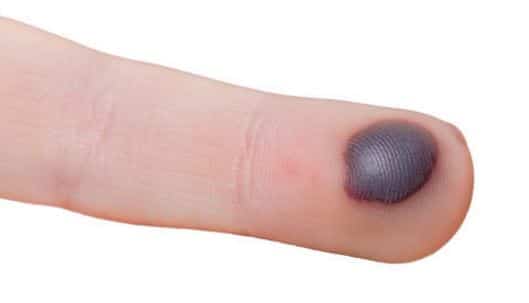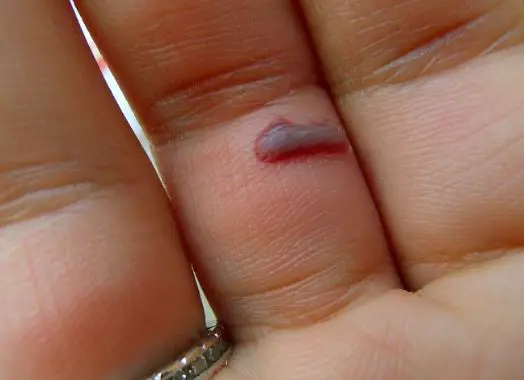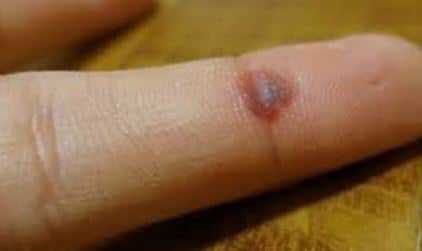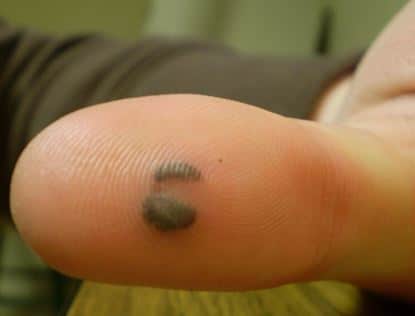A blood blister on finger or fingernail can be painful and a source of discomfort? This article aims at reviewing the healing process of this condition, how to treat including both medical and home remedies, the underlying causes, the available treatment options and the pictures to give you a deeper understanding of the same.
Blood blisters are small vesicles that are filled with fluid which forms under the skin following rubbing, a pinch, sun burn or any other kind of burn. If the blister is filled with blood, it is an indicator that the wound is slightly deeper and has caused the small blood vessels to rupture having the blood trapped under the skin.

Blood blisters on finger
Causes of blood blister on finger, fingernail and fingertips
The occurrence and existence of blood blisters on the finger can be very annoying and make it hard for you to carry on your daily activities. The blisters can be brought about by diverse number of causes. They include the following:
1. Trauma or injury
Trauma or an injury can make the blood vessels under the skin to become damaged and this leads to accumulation of blood. Possible causes of trauma like forceful pinching of the skin and accidents cause injury and hence blister. The resulting blister is normal and is likely to heal on its own without any treatment. It takes about 10 days to be off unless it is infected.
2. Fungal infection on the skin
The infection is mainly brought about by the Tinea manuum. This infection occurs either on one hand or both hands. This fungus is rarer than the Tinea pedis that affects the feet. The resulting blisters may have a rash that contains a sticky clear fluid, itches, and even burns. Various reasons could be the cause of the blisters:
- Getting in contact with fungus through persons effects like towels
- Contact with an infected animal
- Getting into any contact with an infected person
3. Viral infections
Varicella zoster, a virus that causes chicken pox and shingles is the commonest cause of viral-caused blood blisters. The moment you are infected with the virus, the body develops antibodies that make you immune to future attacks by the virus. The virus on the other hand does leave your system and this leaves you vulnerable to future attacks by shingles.
The other virus that could make you get the condition is the herpes simplex virus. This same virus causes herpes. This virus is very highly contagious and it would therefore be good for you avoid contact with any infected source.
4. Impetigo
This is a common cause of blood blisters and sores in children and young adults. It is very contagious but not very serious because it can clear on its own without the need for any medical treatment used. You will notice or identify the condition by presence of the following symptoms:
- A painless itch sore
- High fever
- Red sores that burst leaving behind a thick golden crust
- Itchy and painful blister, also called bollous impetigo
- Blisters that spread quickly
- Swollen lymph nodes
5. Medical allergic reaction
Allergy to drugs, also called medical allergy is common in many people on fingers and other parts of the body. It is the reaction of the immune system to allergens, and in this case drugs like the antibiotics, anti-inflammatory and over the counter drugs. The symptoms of medical allergy include the following:
- Itchy eyes
- Running nose
- All types of skin rash
- Blisters and sores on the skin
6. Eczema
The specific type of eczema, called the pompholyx is the one known to cause tiny blisters that grow across the fingers, palm, and even the hand. It is also known as dyshirotic eczema and it affects people under the age of 40 years. The condition begins with intense itching and burning sensation. Eventually, it erupts into tiny blisters that ooze fluids. The common causes of this condition are:
- Fungal infections
- Excessive sweating
- Stress
- Chemicals and other allergic reactants in the environment
Mild cases of the condition go away within a week or two. However, chronic cases may call for the use of topical ointments and skin emollients, which help in the healing process. Steroid creams are also useful in reducing inflammation and irritation.
7. Sunburn
When the body gets exposure to the sun, there are the very powerful ultraviolet rays that burn the skin. The color of the skin changes gradually into bright red or pink and there may be some lesions or blisters on the affected area. The damage caused is permanent and the only remedy available is to try treating the symptoms arising.
If the skin gets exposure to the rays, the skin’s defense mechanism is exhausted and hence the skin gets red and blisters form later on. People with a light complexion are more prone to effects of sunburn compared to those of dark complexion.
8. Frostbite
Frostbite is most common on the fingers, toes, nose, ears, cheeks, and chin. Because of skin numbness, you may not realize you have frostbite until someone else points it out. Frostbite is most common on the fingers, toes, nose, ears, cheeks, and chin. Because of skin numbness, you may not realize you have frostbite until someone else points it out.
Chronic stage of the frostbite leads to the formation of blood blisters on the fingers and the fingernails. Large blisters form 24 to 48 hours after re-warming. Afterward, the area turns black and hard as the tissue dies.
9. Friction
Blood blisters on your fingers are also commonly brought about by friction against the surface of the skin on your fingers. A blood blister can be very painful when it first develops. Blood blisters resemble friction blisters in size and shape; the only difference is they appear darker from the small amount of blood trapped between layers of skin.
Pictures of blood blister on finger
This article also has some pictures that give you a clear visualization of how the blood blisters look like to better your understanding. The images are generated from internet and therefore a variation is expected from one individual to another. Your doctor will be able to help you come to a conclusion of the blister that you are having.


What to do with a blood blister on finger
Is it ok top to pop the blister on your fingernail? The rule of the thumb is that the blisters should not be popped whatsoever. The outer layers of the blister protect the finger from any impending bacterial and fungal infection. Popping the blister exposes them to many infections. An infected blister on your finger leads to inflammation in the end making it painful and discomforting.
Is it possible to drain the blister safely?
If the blister gets large and very painful, then you can consider draining it safely. The best way to do this is under the supervision of a doctor. This prevents any infection from setting in. the things you will need to this at home are sewing needle and some gauze. Follow the following procedure:
- Sterilize the needle with rubbing alcohol or by heating it over an open flame
- Before the procedure, wash your hands and the blister thoroughly with water and soap
- Carefully poke the blister at the edge with the sterilized needle
- The blood and other fluids will start to ooze out and finally get drained
- Avoid removing the roof from the blood blister as the cover helps in healing process
It is not recommended that you drain the blister if you have HIV, diabetes, cancer or other conditions like the heart disease. This is because this would lead to more loss of blood or worsening of the condition, something that delays the healing process.
Home remedies for blood blisters
There are several treatment options that can be employed to produce a suitable end result. They may include both home remedies and medications prescribed by the doctor. The use of home remedies ought to be under the careful prescription of a doctor.
Cold Compress/Ice
The following procedure is very useful in this regard:
- Apply an ice or a frozen vegetable bag in a towel against the area for 10 minutes.
- Wait 10 minutes and compress the area again.
- The coldness causes blood vessels to constrict, reduces swelling, and stops internal bleeding.
Aloe Vera
Fresh Aloe Vera gel or Aloe Vera juice has inflammatory properties that ease pain and swelling. To do this, follow the procedure below:
- Apply the gel daily for three to four days.
- Apart from that, you can also mix Aloe Vera gel with vitamin E oil in equal parts and apply it to the blood blister.
Garlic Oil
The oil has various components that speed up the healing process and it acts as a disinfectant. To reap the best out of it, use natural garlic oil at room temperature. The procedure is as follows:
- Massage it into the area around the blister, and leave it on for 30 minutes a few times a day.
- Rinse with cool water each time you use the garlic oil, but stop if you notice redness or irritation to the skin.
Sandalwood
A powder draws heat away from a blood blister reducing inflammation and pain. To do this,
- Take sandalwood powder and add rose water to it to make a thick paste.
- Apply the paste several times a day, let it dry, and then rinse with cool water.
Witch Hazel
Witch hazel contains astringent tannins that help dry out the blood blister and reduce pain and swelling. It also helps to dry the blisters quickly by making them to dry out. In order to benefit fully:
- Spread a small amount of witch hazel on the blood blister.
- Do this at least four times a day for a week to two weeks to provide relief from pain and quicken healing of the blood blister.
Tea Tree Oil
There are very many medicinal benefits attached to this oil. It contains antiseptic, antifungal and anti-inflammatory properties that dry out the blister naturally. One of them it is able to speed up the healing process. You could also use creams, lotions, ointments and soaps that have tea tree oil in them. This remedy is not suitable for he pregnant women and the breastfeeding women. Procedure:
- Mix some tea tree oil with water to dilute it, apply it to the blood blister for 10 minutes, and rinse it off with cool water.
- Note however that, this method is not recommended for pregnant or breastfeeding women.
Epson Salt
The mixture of Epson salt and warm water will make the blood blister burst “naturally” and reduce pain and swelling. To do this,
- Add Epson salt to warm water and clean the blood blister two to three times a day with the solution.
Cucumber
This vegetable will help to reduce swelling, pain and inflammation. The procedure is as follows:
- Cut a chilled cucumber into thick slices and put a slice over the blister for a few minutes.
- Repeat the process for several times a day for some days till the blister ids gone
- Drinking a glass of fresh cucumber juice is also helpful
Turmeric
It is well-known for its therapeutic and medicinal properties. It is used to treat skin problems such as minor burns and blisters in this case. It is also antiseptic in nature and can prevent infection from occurring. The procedure is as follows:
- Prepare a paste of one teaspoon of turmeric powder and adequate water or honey.
- Apply it on the blister two or three times a day
- Similarly, you could add one teaspoon of turmeric powder to a glass of warm milk and take it before bed.
You could also have the blisters covered.
It’s very important to keep the skin over your blister intact. This goes to an extent to provide a barrier between the wound under your skin and the bacteria that moves around outside your skin. If your blister is not too painful cover it with an adhesive bandage. For larger blood blisters use a plastic-coated gauze pad. Consider using a gauze that will absorb moisture and allow your blister to breathe.
Keep the blister exposed to air
Most blisters heal on their own in the course of time. Keeping the blister clean and dry allows the healing process to proceed quickly. Keeping the blister exposed also limits the chances of it getting infected.
Reduce any friction or pressure
If you do manual labor and you get a blister on your fingernail it most likely that it will be susceptible to pressure and friction. Always try to keep it away from this injury sources. Exposing it to air paves room for natural healing to start right away. If it stays intact, then the chances of having it burst and infected are minimized.
Tea bags
They contain some acidic element that assists he blister to heal over time. It apart from that has some protective effect to the skin and this prevents the blister from getting worse. To do this, the procedure is a below:
- Put used tea bag in the refrigerator for about 30 minutes.
- Place the moist tea bag on the blister for some minutes
- Repeat the process at least two times in a day for two or three weeks.
Chamomile tea
It is known for its wound healing abilities like the astringent, antioxidant anti-inflammatory properties. Roman chamomile is used for example in cosmetic preparations and soothing and softening the skin. It is also used for skin irritations and bruises, burns, wounds and blood blisters. It can be made with two or three teaspoons of dried chamomile in a teapot
- Poor a cup of hot water over the tea and steep for almost three to five minutes
- Apply the tea with a cotton ball to treat the blood blister
- Use the mixture for three to four times in a day
If your blister is torn, then the procedure below would be good for you:
- Gently wash the area with clean water. Do not use hydrogen peroxide or alcohol as they can slow the healing
- Do not remove e flap over the blister unless it is very dirty or torn or there is pus under it. Gently smooth the flap over the tender skin
- Cover the blister with a layer of petroleum jelly and a non-stick bandage
- Apply more petroleum jelly and replace the bandage as needed
Above all the listed home remedies, there are some antiseptic creams that you can use effectively to get rid of a blister. This is very common with the blisters that are brought about by bacterial infections and other microbes that you might be exposed to. You should always visit you doctor and especially the dermatologist to be able point out the reason and cause of your blood blister.
References and Sources
- http://www.webmd.com/skin-problems-and-treatments/bleeding-under-nail#1
- http://www.yellowpages.ca/tips/should-i-pop-the-blood-blister-on-my-finger/
